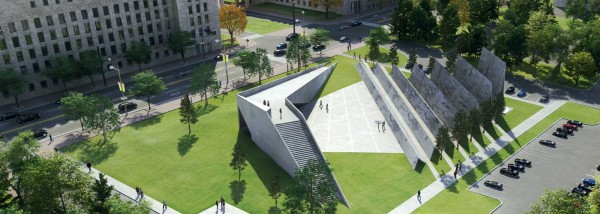Markers of history and memorials to the tragedies of the past are part of how we imagine ourselves, both individually and collectively. It is no accident that these monuments are so often supported by arguments for their importance to our national identity (for better or worse).
As residents of Ottawa, these monuments punctuate our daily lives in a way that the majority of the Canadians they represent never experience. Since many Canadians may never see these monuments in person, the decision to place them in the national capital is obviously intended to carry significant symbolic power and meaning. The symbolic gesture, however, is still tied to the reality of the physical site. And so, the question of which site deserves particular attention.
In Ottawa, we are also familiar with the controversies over many of the decisions and interventions of the National Capital Commission over its 50+ year history. I personally believe many of the great contributions of the NCC are frequently overshadowed by some of its questionable actions. While it is a complex issue and debate, the mandate to direct and maintain a long-term vision and plan for the physical manifestation of our capital is not an easy task.
There is an exception to this regular controversy. I think that the intentions that underlie the Parliamentary Precinct and Confederation Boulevard are intentions that most Canadians, understand, respect, and wish to protect. Because of the politically charged nature of the precinct and its symbolic meaning, its design and programming must be vigilant in maintaining the impartial, just, and nonpartisan aspirations in order to represent all Canadians.
It is this statement of values that has led to an important dispute over the approved plans for the National Memorial to Victims of Communism.
In a public statement on the issue, the Royal Architectural Institute of Canada explains: “The Long Term Vision and Plan (LTVP) for the Parliamentary Precinct and Judicial Precinct evolved through decades of consultations with leading architects, urban designers and landscape architects.” The statement continues: “We support the intention for the ‘Capital Plateau’ and believe it is rooted in enduring ideas about urban design and building a capital city.
The approved plans for the memorial reportedly disregard the recommendations and advice of the National Capital Commission’s Advisory Committee on Planning, Design, and Realty. According to an article published by MacLean’s, the committee found the site “totally inappropriate”. The inappropriateness of the site is a question of both the surrounding context and scale of the memorial.
Located on a lot west of Parliament, between the Supreme Court of Canada, Justice building, and the Library and Archives of Canada building, the site had been earmarked for a future federal building to complete the “judicial triad”. In terms of scale, the proposed monument is nearly equal in size to the War Memorial plaza on Elgin, and almost three times the size of the Peacekeeping Memorial on Sussex. While the proposed memorial would almost certainly capitalize on the weight of its surroundings and imposing scale, a respectful public work should not unduly detract meaning and significance in return.
In a letter to deputy minister of Public Works, Chief Justice McLachlin expresses her concerns: “Regrettably, some of the proposed designs for the memorial could send the wrong message within the judicial precinct, unintentionally conveying a sense of bleakness and brutalism that is inconsistent with a space dedicated to the administration of justice”. The Chief Justice’s comments reflect key architectural design considerations; scale, context, and materiality.
Though it was not the NCC committee’s role to select the design, members of the committee have also made public comments that they were not in favour of the selected design. Their statements echo those of members of the jury whose role it was. Shirley Bloomberg, a founding partner of KPMB Architects and member of the selection jury, has spoken out against the design, its technical and economic feasibility, and appropriateness to the site.
Architect Barry Padolsky has also been leading local public awareness on this issue. Padolsky has been involved in many local heritage projects, including partnering with KPMB on the restoration of the Museum of Nature. Padolsky has added to his list of concerns the value of the land. The donation of the government land has been announced as a $1 million contribution. Padolsky argues that the land is worth significantly more—anywhere from $16-30 million according to a private evaluation.
Last month, mayor Jim Watson voiced his concerns over the lack of consultation with the city, underlining a common thread among most critics—the lack of transparency, consultation, or meaningful response from the government on this issue.
Toon Dreessen, president of the Ontario Association of Architects, adds: “The irony is that the outcry against this memorial is consistent with democratic ideals and expectations in a free and open society like Canada. The lack of discourse on the location, despite the protests, is antithetical to the democratic process.”
For followers of UrbSanity and for people who know me, you know I usually come to the passionate defence of public art, public places, and the sculptural formal beauty of concrete—even when, maybe even especially when, popularly criticised. Yet, these elements are not sufficient on their own. Public design must be respectful and responsible to both the intended users and the community.
The controversy surrounding this site and design demonstrate an inappropriateness that will do disservice to the memory of those meant to be memorialized and the Canadian values meant to be represented.
Construction is scheduled to begin soon with major elements of the memorial to be completed in time for the fall election.
—
Story: Sarah Gelbard, via yowLAB
This UrbSanity article has been cross-published: yowLAB is Ottawa’s architecture and design ideas lab, fostering and supporting collaborations and exchange of ideas in the community. Follow them on twitter @yow_LAB and on Facebook. *UrbSanity is also published in the Centretown Buzz.
Image: Tribute to Liberty: Canadian Memorial to the Victims of Communism design

